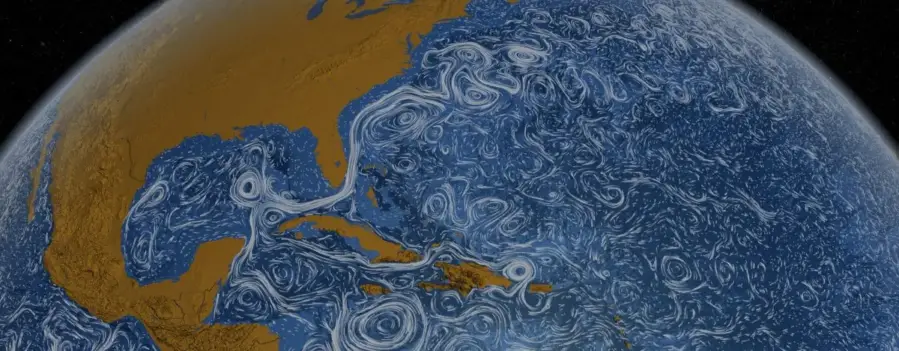Ocean currents swirl in complex patterns beneath the waves, creating underwater weather systems that mirror those in our atmosphere. A groundbreaking study from University of Rochester researchers reveals these oceanic weather patterns interact with atmospheric winds in more nuanced ways than scientists previously understood.
Much like the atmosphere has its storms and pressure systems, the ocean contains its own weather features called eddies – circular currents of water typically measuring about 100 kilometers wide. These underwater weather systems, which transport heat and nutrients throughout the oceans, are significantly influenced by the winds blowing above them.
“It’s actually more interesting than what people had previously thought,” says Hussein Aluie, a professor in the Department of Mechanical Engineering and the Department of Mathematics and senior scientist at the University’s Laboratory for Laser Energetics. “There’s a marked asymmetry in how the wind affects these motions, and it depends on the direction they spin.”
Using satellite data and high-resolution climate models, the researchers discovered that traditional theories about wind simply slowing down ocean eddies were incomplete. Instead, they found that prevailing global winds like the westerlies and trade winds demonstrate a remarkable selectivity – they can either energize or suppress ocean eddies depending on how those eddies rotate.
When ocean eddies spin in alignment with wind patterns, the winds actually energize these underwater vortices. Conversely, when eddies spin counter to wind patterns, the winds dampen their energy. This selective relationship creates distinctive patterns across different ocean regions, with subtropical winds energizing clockwise-spinning eddies while damping counterclockwise ones.
The research also identified another critical component of ocean weather – intricate tangles of current patterns called “strain” that exist between the more visible circular eddies. These strain patterns account for approximately half of the ocean’s kinetic energy and respond to winds in ways similar to eddies.
“The new energy pathways between the atmosphere and the ocean that we discovered can help design better ocean observation systems and improve climate models,” says Shikhar Rai, first author of the study and a postdoctoral investigator at Woods Hole Oceanographic Institution.
This deeper understanding of ocean-atmosphere interactions could lead to improved predictions of ocean currents, benefiting both commercial shipping and fisheries management. These findings may also enhance our ability to forecast how heat and carbon move between the ocean and atmosphere – critical factors in climate change models.
The research, published in Nature Communications, represents a significant refinement of our understanding of Earth’s complex climate systems, revealing the precise choreography between wind and water that shapes our planet’s oceanic weather patterns.
If our reporting has informed or inspired you, please consider making a donation. Every contribution, no matter the size, empowers us to continue delivering accurate, engaging, and trustworthy science and medical news. Independent journalism requires time, effort, and resources—your support ensures we can keep uncovering the stories that matter most to you.
Join us in making knowledge accessible and impactful. Thank you for standing with us!

